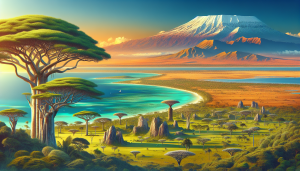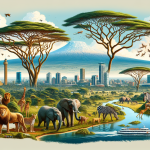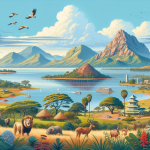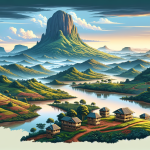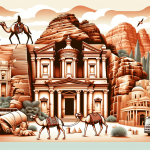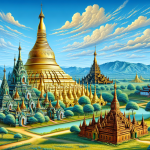Exploring the Wonders of Tanzania: A Complete Travel Guide
Tanzania, a country of immense natural beauty and cultural richness, offers an unparalleled experience for travelers. From the iconic Serengeti National Park, known for its breathtaking wildlife and the annual Great Migration, to the towering Mount Kilimanjaro, the highest peak in Africa, Tanzania captivates visitors with its diverse landscapes and rich heritage. This East African nation, bordered by Kenya, Uganda, Rwanda, Burundi, the Democratic Republic of Congo, Zambia, Malawi, and Mozambique, also boasts stunning coastlines along the Indian Ocean, featuring pristine beaches and turquoise waters. The welcoming and vibrant cultures of the Maasai, Chaga, and Sukuma people further add to the allure of this incredible destination. In this comprehensive guide, we’ll explore the many facets of Tanzania, offering insights into the must-visit places, local traditions, and practical travel tips to ensure you make the most of your Tanzanian adventure.
Serengeti National Park
The Serengeti National Park, a UNESCO World Heritage Site, is undoubtedly one of Tanzania’s most famous attractions. Known for its sprawling savannas and diverse wildlife, the Serengeti offers an authentic safari experience that is hard to match. The park spans over 14,750 square kilometers and is home to the Big Five: lions, leopards, elephants, buffalo, and rhinos. However, what truly sets the Serengeti apart is the Great Migration, one of the most spectacular natural events on Earth. Each year, over 1.5 million wildebeest, along with hundreds of thousands of zebras and gazelles, migrate in a circular route across the Serengeti and Maasai Mara in search of greener pastures. This awe-inspiring journey attracts tourists and photographers from around the world, eager to witness the dramatic river crossings and predator-prey interactions. In addition to the wildlife, the Serengeti’s landscapes, from the endless plains to the rocky outcrops known as kopjes, offer a stunning backdrop for any safari adventure.
Mount Kilimanjaro
Mount Kilimanjaro, the highest free-standing mountain in the world, is a bucket-list destination for trekkers and adventure enthusiasts. Standing at 5,895 meters (19,341 feet), this dormant volcano presents a formidable challenge but also offers a rewarding experience for those who reach its summit. The trek to the top of Kilimanjaro takes you through diverse climatic zones, from tropical rainforests at the base to alpine deserts and, finally, the icy summit. Several routes, including the Marangu, Machame, Lemosho, and Rongai, cater to different skill levels and preferences, each offering unique scenic vistas. While the climb is demanding, requiring adequate preparation and acclimatization, the sense of accomplishment and the breathtaking views from Uhuru Peak make it all worthwhile. Moreover, Mount Kilimanjaro’s slopes are also rich in biodiversity, home to unique plant species and wildlife, adding to the allure of this iconic mountain.
Zanzibar Archipelago
The Zanzibar Archipelago, comprising the main islands of Unguja (commonly referred to as Zanzibar) and Pemba, along with numerous smaller islets, is a tropical paradise off the coast of Tanzania. Known for its pristine white-sand beaches, crystal-clear waters, and vibrant coral reefs, Zanzibar is a haven for beach lovers, divers, and snorkelers. Stone Town, the historic heart of Zanzibar City, is a UNESCO World Heritage Site that reflects the island’s rich cultural tapestry, influenced by African, Arab, Indian, and European traders over the centuries. Wandering through the narrow streets of Stone Town, you’ll encounter intricately carved wooden doors, bustling markets, and historic buildings such as the House of Wonders and the Old Fort. Beyond Stone Town, Zanzibar offers a range of activities, from spice tours that explore the island’s fragrant plantations to dhow cruises that provide a romantic sunset experience. The island’s marine life, including dolphins, sea turtles, and colorful fish, also makes it a popular destination for underwater exploration.
Ngorongoro Crater
The Ngorongoro Crater, often referred to as the “Eighth Wonder of the World,” is a geological marvel and a wildlife haven. Formed by a collapsed volcano, this massive caldera spans approximately 260 square kilometers and boasts one of the highest densities of wildlife in Africa. The crater floor is home to a diverse array of animals, including the Big Five, hippos, wildebeest, zebras, and flamingos that flock to the soda lakes. The lush landscapes, from grassy plains to swamps and woodlands, provide a picturesque setting for game drives and wildlife photography. Additionally, the Ngorongoro Conservation Area, which encompasses the crater, is a UNESCO World Heritage Site that also protects the Maasai people and their traditional way of life. Visitors to the crater can learn about Maasai culture through village visits and witness the harmonious coexistence of wildlife and human communities. The Ngorongoro Crater is a must-visit destination for anyone seeking to experience Tanzania’s natural beauty and wildlife diversity.
Tarangire National Park
Tarangire National Park, often overshadowed by its more famous neighbors, Serengeti and Ngorongoro, is a hidden gem that offers a unique safari experience. Known for its large elephant herds and iconic baobab trees, Tarangire is a place where you can escape the crowds and enjoy a more intimate connection with nature. The park covers approximately 2,850 square kilometers and is characterized by a varied landscape that includes river valleys, swamps, and acacia woodlands. The Tarangire River, which flows through the park, attracts a plethora of wildlife, especially during the dry season when animals gather around the water source. In addition to elephants, Tarangire is home to lions, leopards, cheetahs, giraffes, and numerous bird species, making it a birdwatcher’s paradise. The park’s diverse habitats also support unique flora and fauna, including the rare and elusive greater kudu. Whether you’re a seasoned safari-goer or a first-time visitor, Tarangire National Park offers an enchanting and off-the-beaten-path experience.
Lake Manyara National Park
Lake Manyara National Park, though small in size, packs a punch when it comes to biodiversity and scenic beauty. Located at the base of the Great Rift Valley escarpment, the park is renowned for its diverse ecosystems that range from dense forests and acacia woodlands to the alkaline Lake Manyara itself. This diversity supports a wide variety of wildlife, including elephants, buffalo, giraffes, and the famous tree-climbing lions. The lake, which covers about two-thirds of the park’s area, is a birdwatcher’s dream, hosting thousands of flamingos, pelicans, storks, and other waterfowl. The lush groundwater forests provide a stark contrast to the arid landscapes of northern Tanzania, offering a unique environment where you can spot blue monkeys, baboons, and even leopards. The park also offers opportunities for canoeing on the lake, guided walking safaris, and night game drives, allowing visitors to experience its wildlife and landscapes from different perspectives. Lake Manyara National Park may be less visited than its larger counterparts, but it offers a rich and rewarding safari experience.
Cultural Experiences in Tanzania
Beyond its natural wonders, Tanzania offers a wealth of cultural experiences that provide insight into the country’s diverse heritage. The Maasai people, one of Tanzania’s most iconic ethnic groups, are known for their distinctive customs, dress, and semi-nomadic lifestyle. Visiting a Maasai village, or “boma,” allows travelers to learn about their traditional way of life, including cattle herding, beadwork, and ceremonial practices. The Chaga people, who inhabit the slopes of Mount Kilimanjaro, are renowned for their agricultural skills and traditional irrigation systems. A visit to a Chaga village can include a tour of banana and coffee plantations, as well as an exploration of their intricate underground tunnels. The coastal regions and Zanzibar reflect a blend of African, Arab, and Indian influences, evident in the local cuisine, architecture, and music. Participating in a traditional Swahili cooking class or attending a Taarab music performance can provide a deeper appreciation of the region’s cultural fusion. Whether you’re exploring the bustling markets of Dar es Salaam or attending a local festival, Tanzania’s cultural experiences add a rich and vibrant dimension to any visit.
Practical Travel Tips for Tanzania
Traveling to Tanzania requires some preparation to ensure a smooth and enjoyable trip. Here are some practical tips to help you plan your Tanzanian adventure:
- Visa Requirements: Most travelers require a visa to enter Tanzania. It’s advisable to apply for an eVisa online before your trip to avoid long queues at the airport.
- Vaccinations and Health: Ensure you’re up-to-date on routine vaccines and consider getting vaccinations for yellow fever, hepatitis A and B, typhoid, and rabies. Malaria is prevalent in many parts of Tanzania, so take antimalarial medication and use insect repellent.
- Weather and Best Time to Visit: Tanzania has a tropical climate with distinct wet and dry seasons. The best time to visit for wildlife viewing is during the dry season (June to October), while the coastal regions are most enjoyable from December to February.
- Currency and Payments: The Tanzanian Shilling (TZS) is the local currency. Credit cards are accepted in major hotels and restaurants, but it’s advisable to carry cash, especially in remote areas.
- Language: Swahili and English are the official languages. Learning a few basic Swahili phrases can enhance your interactions with locals.
- Transportation: Domestic flights, buses, and private vehicles are common modes of transport. Consider hiring a reputable tour operator for safaris and remote destinations.
- Safety: Tanzania is generally safe for tourists, but it’s important to stay vigilant, especially in crowded areas and at night. Follow local advice and avoid displaying valuables.
With these practical tips in mind, you’re well-prepared to embark on a memorable journey through Tanzania, exploring its natural wonders, cultural treasures, and warm hospitality.
Conclusion
Tanzania is a land of extraordinary beauty and diversity, offering something for every traveler. Whether you’re drawn to the iconic wildlife of the Serengeti, the challenge of climbing Mount Kilimanjaro, the serene beaches of Zanzibar, or the rich cultural experiences, Tanzania promises a journey filled with unforgettable moments. By immersing yourself in the country’s natural landscapes and vibrant traditions, you’ll gain a deeper appreciation for the wonders of this East African gem. As you plan your trip, remember to take the necessary preparations and embrace the adventure that awaits in Tanzania. Happy travels!
For more detailed travel tips and destination guides, visit [Tanzania Tourism](https://www.tanzaniatourism.go.tz/).
